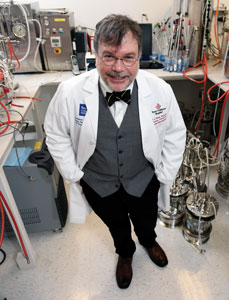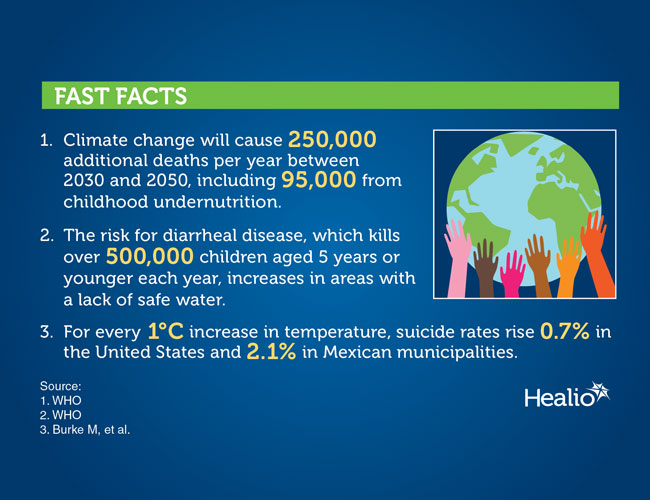Climate change: A growing threat to children’s health
According to WHO, Earth has warmed approximately 0.85°C over the last 130 years — with each of the past 3 decades being successively warmer than any preceding decade since 1850. It will warm more than 3°C this century alone.
WHO also estimated that climate change will cause around 250,000 additional deaths per year between 2030 and 2050 — 38,000 from heat exposure in the elderly, 48,000 from diarrhea, 60,000 from malaria and 95,000 from childhood undernutrition.
According to The Lancet’s annual update on health and climate change, which was published in November, the effects of a warming planet will be particularly harmful to the health of children.

Source: Baylor College of Medicine.
Infectious Diseases in Children spoke with experts about the potential effects that a warming climate could have on the health of the world’s children.
Infectious threats
High among the related dangers to children’s health is the destabilization of ecosystems and water supplies, according to Jeffrey Shaman, PhD, professor of environmental health sciences and director of the climate and health program at Columbia University’s Mailman School of Public Health.
“Changes in water resources and water resource quality in underdeveloped settings are destabilizing and may make it more challenging to control and treat diarrheal disease pathogens — and those are, in particular, a problem for children under 5,” Shaman told Infectious Diseases in Children.

WHO data show that the risk for diarrheal disease, which kills more than 500,000 children aged 5 years or younger every year, increases in areas with a lack of safe water. Variable rainfall patterns can result in droughts, with WHO estimates suggesting climate change will likely increase the frequency and intensity of regional and global droughts by the end of the century.
Climate change also may affect the transmission of infectious diseases like dengue. A 2019 report published in Nature Microbiology estimated that 60% of the world will be at risk for dengue in 2080, citing climate change as a contributing risk factor. However, that risk factor is relatively small compared with population growth and urbanization
Peter J. Hotez, MD, PhD, professor of pediatrics and dean of the National School of Tropical Medicine at the Baylor College of Medicine, said climate change is “not operating in isolation” but works alongside other social factors like food insecurity, urbanization, war or conflict and political instability to drive the spread of new diseases.
“We are going to need new technologies, new vaccines and new drugs for some of these diseases as they emerge,” Hotez told Infectious Diseases in Children. “We are in a bit of an epic struggle between developing these new technologies fast enough vs. the rise of disease due to climate change, together with other social determinants.”
Shaman noted that, because mosquitoes’ life cycles are driven by their environment’s temperature, higher air temperatures can speed up their transition into adulthood — resulting in higher frequencies of bites.
“For mosquitoes, the game is to bite and reproduce as much as possible before dying,” Shaman said. “Warmer temperatures can facilitate reproduction by getting them through the reproductive cycle faster.”

Shaman said changes in rainfall also affect the aquatic environments where mosquitos lay their eggs, resulting in alterations to the quantity and quality of mosquito habitats overall. Malaria killed more than 400,000 people in 2018, most of them African children aged 5 years or younger, according to WHO estimates.
Allergies and asthma
Rising air temperatures resulting from climate change also can impact allergic diseases — which are particularly prevalent among children, according to Jeremy J. Hess, MD, MPH, associate professor of environmental and occupational health sciences, global health and emergency medicine at the University of Washington.
“We’re seeing increases in the length of the pollen season for a number of allergenic pollen directly correlated with changes in temperature over time,” Hess told Infectious Diseases in Children. “We haven’t really yet been able to test whether that is causing more allergic symptoms, but certainly it stands to reason that it would be — and you probably are seeing a larger burden of allergic disease related to climate change as a result of that.”

According to the AAP, shorter winters as a result of climate change have increased the length of allergy seasons, which worsens allergies and increases the chance of asthma symptoms.
Hess noted that excessive heat also can be a risk factor for preterm birth and premature delivery.
“Preterm birth puts kids at risk for any number of different adverse outcomes down the road, and so we worry about that,” Hess said. “We’re trying to get a sense of the magnitude of the risk and what the potential downstream implications might be.”

Nutrition
According to WHO, malnutrition and undernutrition cause an estimated 3.1 million deaths each year. The Lancet report cited malnutrition resulting from climate change as a particularly salient health threat to children, noting global declines in major food sources including wheat (6%), maize (4%), soybeans (3%) and rice (4%). In addition, the CDC has projected climate-related declines in global livestock and fish production.
According to Shaman, climate change’s impact on nutrition is especially threatening to children in sub-Saharan Africa.
“Climate change will likely compound and exacerbate other conditions in sub-Saharan Africa, including malnutrition,” Shaman said. “This feedback is hardest on children — there is a high under-5 mortality rate in sub-Saharan Africa— so exacerbations of diarrheal disease and malnutrition caused by changes in water and food security are of real concern.”
Shaman also noted that “complex downstream effects” resulting from climate change, like forced migration due to rising sea levels and droughts, also can impact nutrition.
“Conditions such as forced migration and conflict, for which climate change can be exacerbating, disrupt food security and increase rates of malnutrition. Children can be most vulnerable in these circumstances.” Shaman said.
Mental health
Rising temperatures resulting from global warming also can have adverse mental health effects on children, experts said.
According to a 2020 Lancet report, 10% to 20% of children and adolescents experience mental health disorders worldwide. A 2018 study published in Nature Climate Change found that for every 1°C increase in temperature, suicide rates rise 0.7% in the United States and 2.1% in Mexican municipalities. The researchers predicted that unmitigated climate change could cause a combined 9,000 to 40,000 additional suicides across the U.S. and Mexico by 2050, suggesting interventions may be necessary to offset adverse mental effects of climate change.
“There are psychological effects we are aware of if there’s damage to the environment that can lead to depression,” Regardt J. Ferreira, PhD, director of the disaster resilience leadership academy and associate professor at the Tulane School of Social Work, told Infectious Diseases in Children. “There can be self-destructive lifestyles as well that originate from climate distress because there’s a hopelessness that comes about, and that relates back to children.”
According to the CDC, some patients with mental illness are especially susceptible to heat, and patients with severe mental illness like schizophrenia are at risk during extreme heat because their medication may interfere with their body’s temperature regulation. In the wake of natural disasters fueled by climate change, CDC data also show that mental health problems increase among people at risk for mental illness, as well as among those with no history of mental illness.
“Stress in children is a problem, too — traumatic stress,” said Frazier B. Beatty, PhD, MPH, CHES, director of the Masters of Public Health program and assistant professor at Regis College. “Let me give you an example — environmental flooding, wildfires, all the types of things that you see, including a lot of the wildfires in California, those traumatic experiences and the mental health stress is really harming children. PTSD is real.”
‘No magic bullet’
An estimated 4.6% of all global carbon emissions come from the health care sector, with emissions increasing across major economies, according to The Lancet report. Hess said physicians can play a pivotal role in reducing the carbon footprint of the health care industry.
“There’s a lot we can do to reduce our own carbon footprint in health care — being mindful and recognizing that greenhouse gas emissions have long-term harms, but they are also are associated in most cases with the emission of other harmful pollutants like particulates, etc.” Hess said. “If we’re committed to reducing harm as physicians, we need to be reducing those emissions that come from health care activities.”
Hotez noted that collaboration across the sciences will be pivotal to mitigating the adverse effects of climate change on global health.
“One of the challenges is that we don’t have good dialogue between microbiologists, virologists and climate change experts — at academic health centers you don’t see earth scientists walking around the halls,” Hotez said. “The key message is that to solve these new 21st century problems, we are going to have to begin this uncomfortable dialogue between the sciences that we haven’t had before.”
Recently, a joint commission established by WHO, UNICEF and The Lancet called for immediate action to protect children against the negative health impacts of climate change and suggested placing them at the center of the Sustainable Development Goals agreed to by United Nations members in 2015. The commission also recommended giving adolescents a voice in creating policy.
“We need to focus on collaboration or collaborative efforts that put prevention first — teach people about the effects of the climate to our health and then teach them about well- being,” Beatty said.

According to Hotez, it is challenging to distinguish between adverse health outcomes resulting from climate change and adverse effects stemming from other issues, such as large populations fleeing conflict zones and the interruption of mosquito control methods.
“We need to better understand infectious disease transmission dynamics, how climate change will change infectious disease burdens in the future, and how we, as a society, can appropriately — within the scope of feasible developments — put in place interventions that limit that burden,” Shaman said. “As with climate change, we want to mitigate infectious disease burdens; we don’t want major outbreaks that spin out of control.”
Hess said prevention efforts also are essential to mitigating climate change’s detrimental health impacts on children, and the associated costs of these efforts are often offset by the overall benefit to public health.
“There’s no magic bullet here,” Hess said. “The best way forward in terms of climate change for all diseases is investing in reducing the emissions from the beginning.” – by Eamon Dreisbach
- References:
- AAP. Climate change and children’s health. https://www.aap.org/en-us/advocacy-and-policy/aap-health-initiatives/climate-change/Pages/Climate-Change-and-Childrens-Health.aspx. Accessed February 18, 2020.
- Blum AJ, Hotez PJ (2018) Global “worming”: climate change and its projected general impact on human helminth infections. PLoS Negl Trop Dis. 12(7):e0006370.
- Burke M, et al. Nat Clim Chang. 2018;doi:10.1038/s41558-018-0222.
- CDC. Climate effects on health. https://www.cdc.gov/climateandhealth/effects/default.htm. Accessed February 18, 2020.
- Clark H, et al. Lancet. 2020;doi:10.1016/S0140-6736(19)32540-1.
- Messina JP, et al. Nat Microbiol. 2019;doi:10.1038/s41564-019-0476-8.
- NIH. Climate and human health. https://www.niehs.nih.gov/research/programs/geh/climatechange/index.cfm. Accessed February 20, 2020.
- Watts N, et al. Lancet. 2019;doi:10.1016/S0140-6736(19)32596-6.
- WHO. Climate change and health. https://www.who.int/news-room/fact-sheets/detail/climate-change-and-health. Accessed February 18, 2020.
- WHO. Threats to global health in 2019. https://www.who.int/news-room/feature-stories/ten-threats-to-global-health-in-2019. Accessed February 20, 2020.
- For more information:
- Frazier B. Beatty, PhD, MPH, CHES, can be reached at frazier.beatty@regiscollege.edu.
- Regardt J. Ferreira, PhD, can be reached at rferrei@tulane.edu.
- Jeremy J. Hess, MD, MPH, can be reached at jeremyjohnsonhess@gmail.com.
- Peter J. Hotez, MD, PhD, can be reached on Twitter at @PeterHotez.
- Jeffrey Shaman, PhD, can be reached at jls106@cumc.columbia.edu.
Disclosures: Hess reports receiving grants from NASA, the National Oceanic and Atmospheric Administration, the National Science Foundation and the Robert Wood Johnson Foundation. Beatty, Ferreira, Hotez and Shaman report no relevant financial disclosures.
